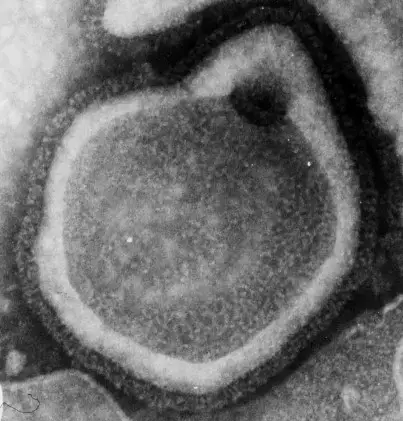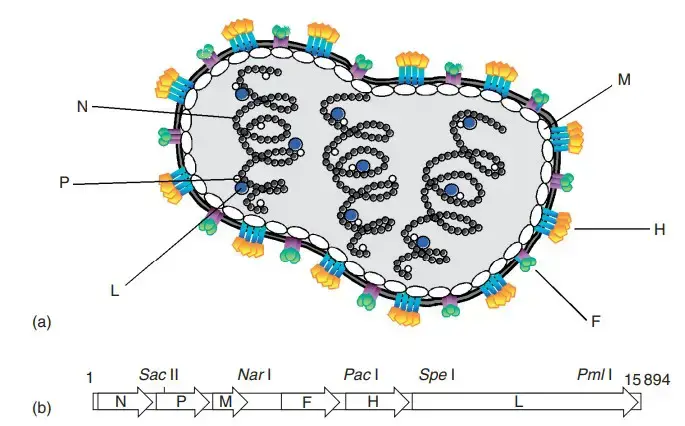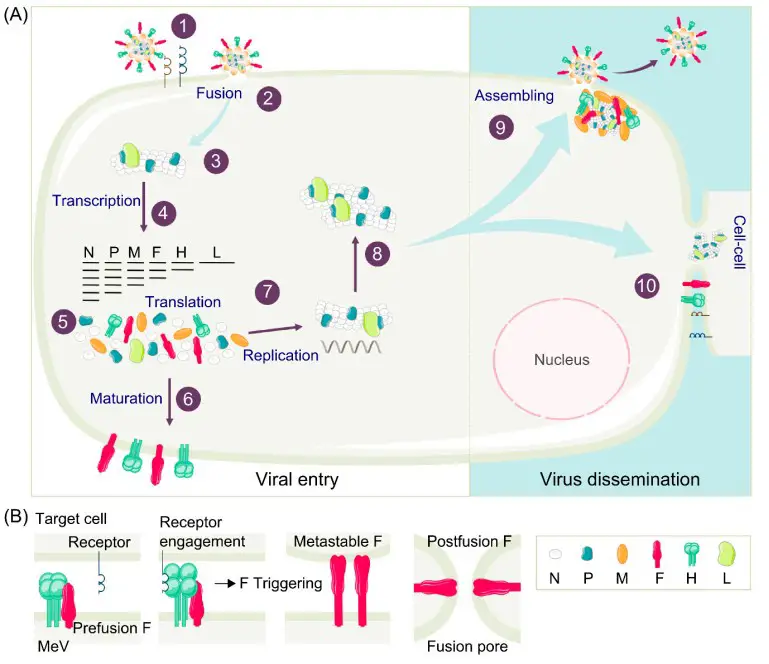- The measles virus (MV) is an enveloped, non-segmented, negative-strand RNA virus belonging to the family Paramyxoviridae, genus Morbillivirus.
- The Paramyxoviridae are important agents of disease, causing both age-old human and animal diseases (measles, mumps, respiratory syncytial virus (RSV), and the parainfluenza viruses) and newly recognized emerging diseases (Nipah, Hendra, and morbilliviruses of aquatic mammals).
- The Paramyxoviridae are distinguished from other negative-strand RNA viruses by the presence of a protein (F) that induces the fusion of viral and cell membranes at neutral pH.
- The organization and expression strategy of the nonsegmented genome of Paramyxoviridae, which includes MV, are comparable to that of Rhabdoviridae.
- Morbilliviruses are distinguished by their lack of neuraminidase activity and their ability to enter cells via the primary receptor signaling lymphocyte activation molecule (SLAM, CD150): MV, canine distemper virus, and rinderpest virus all enter cells via SLAM (human, canine, or bovine, respectively).
- Immunosuppression can be explained by the fact that the cellular distribution of SLAM coincides with the sensitivity of various cell types to infection by wild-type MV.
Structure of Measles Virus

- A lipid bilayer derived from the plasma membrane of the cell in which the virus was grown envelops MV particles. They have been depicted as pleomorphic or spherical, depending on the purification procedures used.
- Their diameter ranges from 120 to 300–1000 nm, which suggests that their payload volume may vary by a factor of 30 and that the large particles are polyploid. Figure 1 depicts glycoprotein spikes inserted into the envelope that extend approximately 10 nm from the surface of the membrane and are visible via electron microscopy.
- Figure 2(a) is a schematic representation of an MV particle. Inside the membrane of a virus is the nucleocapsid nucleus, which typically contains multiple genomes.
- Each genome contains 15,894 nucleotides that are securely encapsulated by a nucleocapsid (N) protein (Figure 2(a)).
- The RNA and the N protein are associated with two other proteins, a polymerase (L for large) and a polymerase cofactor (P for phosphoprotein), to form a replicationally active ribonucleoprotein (RNP) complex.
- The matrix (M) protein condenses the MV RNP, which is then selectively covered by two envelope spikes composed of oligomers of the F and H proteins. The F protein spike is trimeric, while the H protein forms covalently linked dimers that are capable of forming noncovalent tetramers.
- The H protein interacts with cellular receptors, while F is responsible for fusion. This protein is cleaved and activated by the pervasive intracellular protease furin.
- During viral particle assembly, viral proteins are preferentially incorporated while the majority of host proteins are excluded.

Genome Structure of Measles Virus
- Non-segmented, negative-sense, single-stranded RNA makes up the measles virus genome.
- About 16,000 nucleotides make up the RNA genome, which is packaged in a lipid envelope provided by the host cell.
- The transcription and replication of the genome require two non-coding regions, the leader (52 nucleotides) and the trailer (37 nucleotides), at either end of the genome.
- The MeV genome is structured with gene end and start sequences, and has six genes that code for eight viral proteins in the order 3′-N,P,V,C,M,F,H,L-5′.
- The phosphoprotein (P) gene is responsible for transcription of eight proteins; two of these proteins (V and C) are nonstructural proteins.
- Large protein (L) and nucleoprotein (N) are two of the six structural proteins that combine to make the nucleocapsid, which protects the viral RNA.
- The viral envelope is composed of the hemagglutinin (H) protein, the fusion protein (F), and the matrix protein (M), as well as lipids from the host cell membrane.
Epidemiology of Measles Virus
- Measles is a highly contagious viral infection that affects the respiratory system. It is caused by the measles virus and is spread through droplets from the nose, mouth or throat of an infected person. Measles can lead to serious complications such as pneumonia, encephalitis, and death, particularly in young children.
- Before the introduction of the measles vaccine, the disease was common worldwide, with epidemic outbreaks occurring every few years. However, since the introduction of the vaccine, there has been a significant decline in the number of cases of measles. Despite this, measles remains a significant public health concern, particularly in regions where vaccination coverage is low.
- According to the World Health Organization (WHO), in 2019 there were an estimated 869,770 cases of measles worldwide, with 207,500 deaths. The majority of cases and deaths occurred in children under the age of 5 years, particularly in countries with low vaccination coverage. In the same year, there were also several large outbreaks of measles, including in countries with high vaccination coverage such as the United States and the United Kingdom.
- In order to control the spread of measles, it is important to ensure high vaccination coverage rates, particularly in areas with low coverage. Vaccination is highly effective at preventing the disease, and is the most important measure for preventing outbreaks of measles. Other measures such as isolation of infected individuals and contact tracing can also be effective in controlling outbreaks.
Transmission of Measles Virus
- Measles virus is highly contagious and can spread easily from person to person through the air. When an infected person talks, coughs, or sneezes, they release droplets into the air that contain the virus. These droplets can stay in the air for several hours and can infect anyone who breathes them in.
- Measles virus can also spread through contact with surfaces contaminated with the virus. If an infected person touches their nose or mouth and then touches a surface, such as a door handle or a toy, the virus can survive on that surface for several hours. If someone else touches the contaminated surface and then touches their nose or mouth, they can become infected.
- People are most contagious with measles from about 4 days before to 4 days after the rash appears. This means that someone with measles can spread the virus even before they know they are infected.
- Measles is highly infectious, and it only takes a small number of cases to start an outbreak. Outbreaks are more likely to occur in areas with low vaccination coverage, where the virus can spread quickly among unvaccinated individuals.
Replication of Measles Virus

- To infect a susceptible and permissive cell, MeV bonds to its entry receptors on the cell surface (1) and initiates virus-cell membrane fusion (2), as detailed in (B).
- The transfer of the genome into the cytoplasm is caused by the fusion of virus and cell membranes (3). RNA viruses are transcribed into messenger RNA (4), which is then translated into viral proteins (5).
- During transport to the cell surface, viral glycoproteins (6) mature. Anti-genomic RNA replication begins in the cytoplasm (7) and functions as a template for the synthesis of new negative-stranded genomic RNA (8).
- At the cell surface, viral proteins assemble, resulting in either the release of new virions (9) or cell-to-cell fusion (10).
- (B) The haemagglutinin (H) protein binds to the MeV receptor on the cell surface, triggering fusion (F) that reaches a metastable conformation.
- Then, the F protein anchors its fusion peptide in the target cell membrane, and F undergoes serial conformational changes that bring the two membranes together to coalesce and form a pore through which the viral ribonucleocapsid (RNP) is delivered to the cytoplasm.
Pathogenesis of Measles Virus
- Measles virus is primarily transmitted through respiratory droplets and small-particle aerosols that remain suspended in the air. Once the virus enters the body, it replicates in the respiratory tract and then spreads to the local lymphatic tissues.
- The virus then spreads to multiple lymphoid tissues and other organs, including the skin, kidneys, gastrointestinal tract, and liver, through a process known as primary viremia. The virus spreads predominantly through cell-to-cell transmission.
- Measles virus can be detected in peripheral blood leukocytes during the prodromal symptoms and for several days after the onset of the rash.
- The virus replicates in endothelial cells, epithelial cells, monocytes, and macrophages in various organs. The formation of multinucleated giant cells is a pathological hallmark of measles infection.
- The virus can also spread systemically to other organs and tissues through infected circulating immune cells. Rarely, the virus can infect endothelial cells, neurons, astrocytes, and oligodendrocytes in vivo.
- The measles virus can persist in neurons as a defective variant, which spreads from neuron to neuron directly, avoiding detection and elimination by circulating high titers of measles virus-specific neutralizing antibody.
- The persistence of measles virus in the central nervous system (CNS) can lead to progressive fatal encephalitis known as SSPE, which can develop several months to years after infection and recovery from acute measles virus.
- Although the mechanism behind this autoimmune response is not well understood, it has been suggested that “molecular mimicry” based on structural similarities between MeV proteins and myelin could be a pathogenic mechanism.
- The hallmark of SSPE is demyelination, which results in ataxia, motor and sensory loss, mental status changes, and can lead to death.
Clinical manifestations of Measles Virus
- The clinical manifestations of measles virus typically begin with fever, malaise, cough, coryza, and conjunctivitis, also known as the prodromal phase. This is followed by the development of a characteristic rash, which typically begins on the face and then spreads to the trunk and limbs over the next few days.
- The rash consists of small, red, flat spots that gradually enlarge and become raised. The spots may also become confluent, forming larger patches of redness. The rash typically lasts for about 5-6 days and then fades, leaving a brownish discoloration.
- Other common symptoms of measles virus include a sore throat, headache, and muscle pain. In some cases, complications such as pneumonia, otitis media, and encephalitis may occur. Measles virus infection can be particularly severe in infants, pregnant women, and individuals with weakened immune systems.
- After the initial infection, the individual develops lifelong immunity to measles virus. However, in rare cases, individuals may develop a condition called subacute sclerosing panencephalitis (SSPE), which is a progressive and fatal neurological disorder that occurs several years after the initial infection.
- Overall, measles virus infection can cause a range of clinical manifestations, from mild to severe, and can lead to significant morbidity and mortality, particularly in populations with low vaccination coverage. Vaccination is the most effective way to prevent measles virus infection and its complications.
Complications
If not properly treated, measles can result in chronic complications such as pneumonia, encephalitis, etc. Other possible complications include:
- Bronchitis
- Reduced number of blood platelets
- Severe diarrhoea
- Sometimes even blindness
Laboratory diagnosis Methods of Measles Virus
- There are several laboratory methods for diagnosing measles virus infection. The most common method is to detect specific IgM antibodies against measles virus in blood serum. These antibodies are typically detectable within a few days of the onset of the rash and can persist for several weeks.
- Other laboratory methods include detecting the presence of viral RNA or antigen in respiratory secretions or blood samples using polymerase chain reaction (PCR) or enzyme-linked immunosorbent assay (ELISA), respectively. These methods can provide a rapid diagnosis of measles virus infection, but they are generally less sensitive than detecting IgM antibodies.
- Viral isolation from respiratory secretions, urine, or blood can also be used for laboratory diagnosis, although this method is more time-consuming and requires specialized facilities.
- It is important to note that laboratory diagnosis should always be complemented by clinical and epidemiological data to confirm a diagnosis of measles virus infection. In addition, the laboratory should be notified if there is a suspicion of measles virus infection, as this is a notifiable disease in many countries.
Treatment of Measles
There is no specific measles treatment. Generally, the virus and symptoms vanish within two to three weeks, but the doctor may recommend the following treatments:
- Medications that strengthen the immune system
- Medications to alleviate coughing and throat pain
- Acetaminophen for the relief of muscle aches and fever
- Dietary sources of vitamin A
It is recommended that children be thoroughly monitored by a medical professional. Children should be isolated until they have recovered completely.
Prevention and control
- Prevention and control of measles virus infection involves a combination of vaccination, surveillance, and outbreak response measures.
- Vaccination is the most effective way to prevent measles virus infection. The measles, mumps, and rubella (MMR) vaccine is a safe and effective vaccine that provides long-lasting immunity against measles virus. The World Health Organization (WHO) recommends that all children receive two doses of the MMR vaccine, with the first dose given at 9-12 months of age and the second dose given at 15-18 months of age.
- In addition to vaccination, surveillance is important for detecting and responding to measles virus outbreaks. This includes monitoring of reported cases, laboratory confirmation of cases, and investigation of outbreaks to identify the source of infection and prevent further spread.
- Outbreak response measures may include targeted vaccination campaigns, isolation of cases and contacts, and public health messaging to increase awareness of the importance of vaccination and other preventive measures.
- Other preventive measures include maintaining high vaccination coverage in populations, particularly in areas with low coverage or high risk of outbreaks, and ensuring that healthcare workers are vaccinated and trained in infection control measures.
- Overall, a comprehensive approach to prevention and control of measles virus infection is critical to reducing morbidity and mortality associated with this disease.
FAQ
What is measles virus?
Measles virus is a highly contagious virus that causes a febrile illness characterized by a rash.
How is measles virus transmitted?
Measles virus is transmitted by respiratory droplets and small-particle aerosols that remain suspended in the air for long periods of time.
What are the clinical manifestations of measles virus infection?
The clinical manifestations of measles virus infection include fever, cough, coryza, conjunctivitis, and a characteristic maculopapular rash.
What is the incubation period of measles virus infection?
The incubation period of measles virus infection is typically 10-14 days, but it can range from 7-21 days.
How is measles virus infection diagnosed?
Measles virus infection is diagnosed by clinical presentation and laboratory testing, including detection of specific IgM antibodies, viral RNA or antigen, and viral isolation from respiratory secretions or blood.
Can measles virus infection be treated?
There is no specific treatment for measles virus infection. Supportive care is provided to manage symptoms, and complications may require specific treatments.
Is there a vaccine available for measles virus?
Yes, the measles, mumps, and rubella (MMR) vaccine is a safe and effective vaccine that provides long-lasting immunity against measles virus.
Who should receive the measles vaccine?
The WHO recommends that all children receive two doses of the MMR vaccine, with the first dose given at 9-12 months of age and the second dose given at 15-18 months of age.
What are the complications of measles virus infection?
Complications of measles virus infection include pneumonia, encephalitis, and death. Long-term complications include subacute sclerosing panencephalitis (SSPE), a rare but fatal neurological complication.
How can measles virus infection be prevented?
Measles virus infection can be prevented through vaccination, surveillance, outbreak response measures, maintaining high vaccination coverage, and ensuring healthcare workers are vaccinated and trained in infection control measures.
References
- Cattaneo, R., & McChesney, M. (2008). Measles Virus. Encyclopedia of Virology, 285–291. doi:10.1016/b978-012374410-4.00443-x
- Azap, A., & Pehlivanoglu, F. (2014). Measles. Emerging Infectious Diseases, 347–357. doi:10.1016/b978-0-12-416975-3.00026-1
- Moss, W. J., Griffin, D. E., & Feinstone, W. H. (2009). Measles. Vaccines for Biodefense and Emerging and Neglected Diseases, 551–565. doi:10.1016/b978-0-12-369408-9.00030-5
- Cerutis, R. (2007). Measles (Rubeola). xPharm: The Comprehensive Pharmacology Reference, 1–5. doi:10.1016/b978-008055232-3.60911-0
- Ferren, Marion & Horvat, Branka & Mathieu, Cyrille. (2019). Measles Encephalitis: Towards New Therapeutics. Viruses. 11. 10.3390/v11111017.
- https://www.webmd.com/children/vaccines/what-is-measles
- https://www.mayoclinic.org/diseases-conditions/measles/symptoms-causes/syc-20374857
- https://www.cdc.gov/measles/hcp/index.html
👍
The WHO recommends that all children receive two doses of the MMR vaccine, with the first dose given at 9-12 months of age and the second dose given at 15-18 months of age.
The measles virus (MV) is an enveloped, non-segmented, negative-strand RNA virus belonging to the family Paramyxoviridae, genus Morbillivirus.
Complications of measles virus infection include pneumonia, encephalitis, and death. Long-term complications include subacute sclerosing panencephalitis (SSPE), a rare but fatal neurological complication.